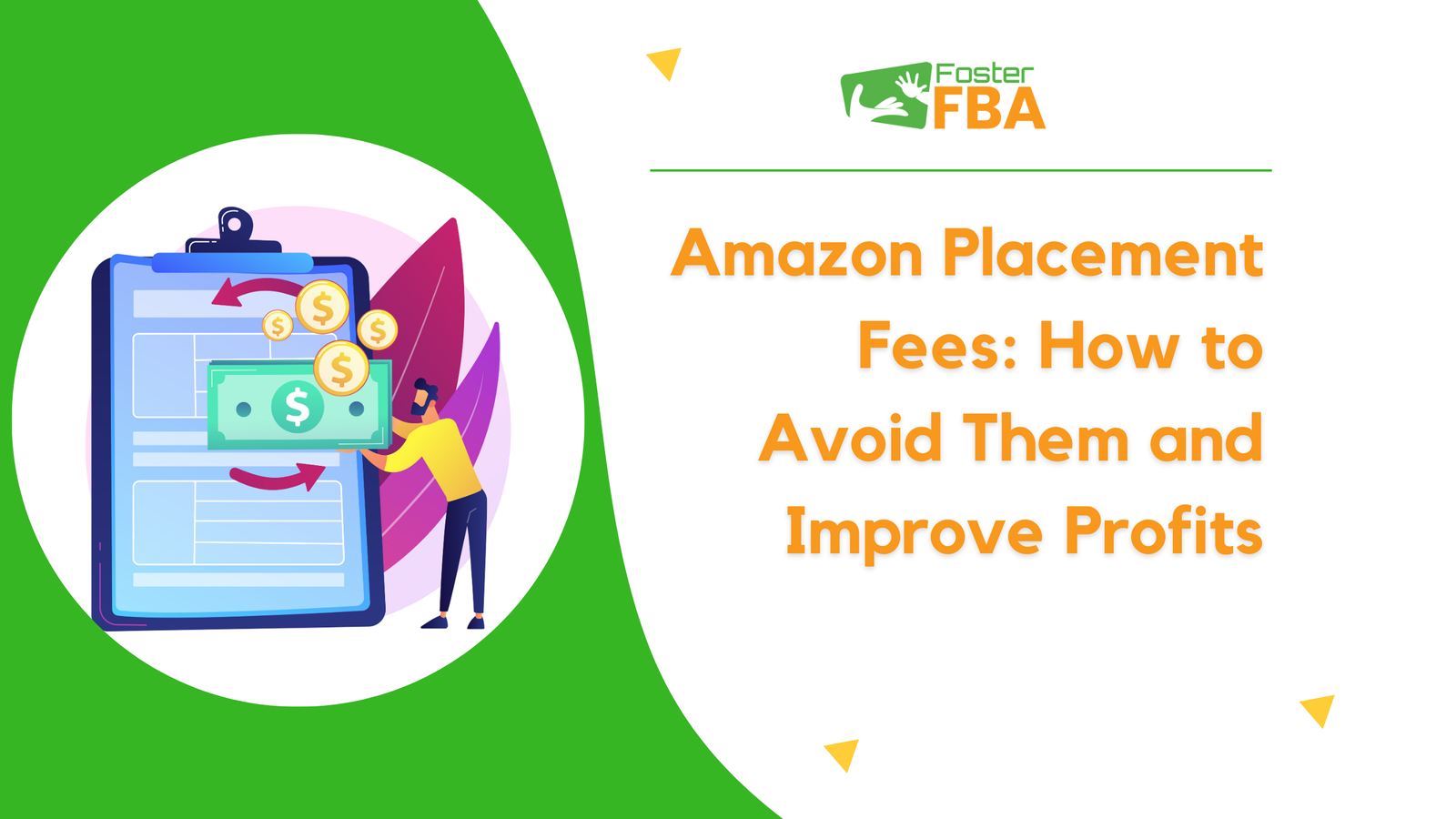The complexities of Amazon’s marketplace just got trickier with the introduction of new placement fees, especially with major sales events like Amazon Prime Day around the corner. For many sellers, these fees seem like another hurdle in the already challenging journey of maximizing profits and staying competitive. However, there’s a silver lining. By understanding the intricacies of these fees and implementing strategic measures, sellers can dodge unnecessary costs and enhance their profitability.
This blog will discuss the new Amazon placement fees, offering practical advice and innovative strategies to help sellers turn potential obstacles into opportunities for growth and improved financial performance. Join us as we explore how to outsmart these fees and improve your Amazon business to new heights.
Key Takeaways
- Understand the new Amazon placement fees and how they are calculated based on factors such as product size, weight, distribution strategy, and fulfillment center locations.
- Consider your shipping options carefully to minimize or eliminate placement fees by selecting the most cost-effective distribution strategy.
- Utilize comprehensive tools to analyze market trends, optimize inventory management, and make informed decisions that maximize profitability.
- Transform underperforming SKUs into successful products by reevaluating their cost structure, sales performance, and marketing strategies.
- Implement quick strategic changes in inventory optimization, marketing tactics, and utilization of Amazon’s advertising tools to drive long-term benefits and improve financial performance.
- See Amazon’s new placement fees as an opportunity to streamline operations, enhance product offerings, and drive greater profitability rather than just a challenge to find. This is particularly crucial as sellers prepare for high-traffic events such as Amazon Prime Day.
What is Placement Fee?
The term “Placement fee” typically denotes the mutually agreed upon monetary compensation between two parties to provide placement services.
This term is commonly utilized in recruitment and advertising, encompassing payments made for positioning services rendered by suppliers to their clientele.
Understanding Amazon Placement Fee
The FBA inbound placement service fee covers the expense of strategically distributing inventory to Amazon’s fulfillment centers near customers. This fee became effective as of March 1, 2024.
Amazon strategically distributes your inventory among various fulfillment centers to ensure speedy delivery of orders to customers. By doing so, this method allows for quicker product delivery to buyers compared to shipping from a more remote location.
To meet this goal, Amazon strategically locates its inventory in various fulfillment centers nationwide to be closer to customers. The Amazon inbound placement service fee applies to standard and large bulky items, covering the expenses associated with distributing inventory to fulfillment centers near customers.
The fee will be applied 45 days following the arrival of your shipment, based on the location and quantities received by Amazon from you.
- Inbound placement options: Amazon provides two choices for where you can place your inventory upon arrival. You can select between these options when setting up a shipping plan within your Seller Central account.
- Minimal shipment splits: This option allows you to send your inventory to a single fulfillment center of your choice, from where Amazon will distribute them to other locations within their network for an extra fee per item. The exact fee varies depending on the area, with higher costs in the Western region of the United States.
- Partial or Amazon-optimized shipment splits: By selecting this alternative, you can personally send your inventory to multiple fulfillment centers, reducing or eliminating fees. Suppose you choose to distribute your inventory to 2 or 3 of the fulfillment centers Amazon recommends (partial distribution). In that case, a lower fee will be incurred. Opt to send your inventory to 4 or more fulfillment centers suggested by Amazon. You can altogether avoid the per-item fee.
To utilize these choices, your shipping strategy must meet specific criteria. Eligibility is determined by the type and quantity of products, your current Amazon inventory levels, and the customer’s location.
What Factors Determine Amazon’s Inbound Placement Service Fee?
Calculating the FBA Inbound Placement Service Fee involves a nuanced assessment of several key factors, including product dimensions, weight, the chosen distribution strategy across Amazon’s fulfillment network, and the geographic location of these fulfillment centers.
Below, we delve into the intricate process Amazon employs to determine this specific fee, expanding upon each element to offer a clearer understanding.
Item Size and Weight Classification
Amazon categorizes products into distinct size tiers such as small standard-size, large standard-size, or large bulky items. This classification is crucial as it influences the base metric for calculating the inbound placement service fee. The differentiation is based on both the physical dimensions and the weight of the product, applying the following criteria:
- Small Standard-Size Items: For these items, the fee calculation primarily considers the unit weight. These products are typically smaller, and lighter, and require less space and handling during the shipping process.
- Large Standard-Size and Bulky Items: For larger items, Amazon employs a more complex calculation, considering either the dimensional weight (which accounts for the volume the item occupies) or the actual unit weight, depending on which is greater. This approach ensures that the fee accurately reflects the logistical challenges and costs associated with handling and storing larger, more cumbersome products.
Number of Fulfillment Centers
The fee is also affected by the distribution strategy sellers choose for their inventory, which determines how many fulfillment centers the products are sent to.
Amazon offers three primary options:
- Minimal Split: Choosing this option aims to consolidate shipments as much as possible, reducing the number of fulfillment centers involved. This can be a cost-effective choice if it aligns with Amazon’s logistical and operational requirements.
- Partial Split: This option represents a middle ground, offering some consolidation while distributing inventory across a few more fulfillment centers to potentially increase product availability across regions.
- Amazon-Optimized Split: This strategy relies on Amazon’s algorithms to distribute inventory across its network in an optimized fashion, potentially involving more fulfillment centers. While this can increase the product’s availability to customers and improve delivery times, it may also lead to higher inbound placement service fees due to the increased complexity and logistics involved.
Fulfillment Center Destination
The geographic location of the fulfillment centers (inbound locations) to which the inventory is sent plays a significant role in determining the fee.
Factors influencing this include:
- Geographic Region: Certain regions may incur higher fees, reflective of higher operational costs or logistical complexities. For example, sending inventory to fulfillment centers in the West might be more expensive than to other regions due to factors like transportation costs and regional demand dynamics.
- Location-Specific Costs: The inbound placement service fee accounts for localized costs associated with logistics, labor, and storage within different areas of Amazon’s vast fulfillment network. These variances ensure that the fees are aligned with the actual costs of processing and storing products in specific locations.
Understanding the intricacies of how Amazon calculates the inbound placement service fee is crucial for sellers to optimize their shipping plans and manage costs effectively. By considering the product size and weight, the distribution strategy, and the specific fulfillment center locations, sellers can make informed decisions that balance cost efficiency with operational effectiveness.
How To Maximize Your Margins Despite Amazon’s New Placement Fees w/ Alex Gardner
The advent of Amazon’s new fees has undeniably introduced a new challenge for FBA owners. However, Alex Gardner, with his extensive background in finance and success as an FBA entrepreneur, posits that these changes should be viewed through a lens of opportunity. Gardner emphasizes that these fees, while seemingly daunting, can serve as a lever for optimizing business operations and driving greater profitability.
He advocates for a strategic reassessment of one’s business model, suggesting that the fees can incentivize FBA owners to streamline their inventory, improve their logistics, and ultimately enhance their product offerings to maximize margins.
3 Profit-Boosting Methods Revealed by Alex Gardner
Method 1: Utilizing Comprehensive Tools
To navigate the complexities introduced by the new fees, Alex Gardner underscores the importance of using a suite of comprehensive tools. He points out that while there are 11 tools in total, starting with three key ones can significantly impact margin maximization.
These tools encompass a range of functionalities, from advanced analytics for better decision-making to inventory management systems that optimize storage and logistics costs. Gardner stresses the value of these tools in providing real-time insights into market trends, competitive analysis, and customer preferences, enabling FBA owners to make informed decisions that align with the new fee structure.
Method 2: Transforming Failing SKUs into Winners
One of the perennial challenges for FBA owners is managing underperforming Stock Keeping Units (SKUs). Alex Gardner reveals a transformative approach that involves a strategic adaptation in financial structuring to revitalize these products. This method is not merely about minimizing losses but rather reimagining these SKUs’ potential.
By analyzing the cost structure, sales performance, and market positioning of these products, FBA owners can identify areas for improvement, such as cost reduction, pricing strategy adjustments, and targeted marketing campaigns. Gardner’s approach offers a blueprint for turning failing SKUs into profitable assets, thereby turning a potential weakness into a competitive advantage.
Method 3: Implementing Quick Changes for Long-term Benefits
The final method Gardner proposes focuses on the implementation of quick, strategic changes that yield long-term benefits. He provides a clear, step-by-step guide for FBA owners to adapt their business operations in light of the new fees. This includes recommendations for inventory optimization, such as reducing overstock and prioritizing high-margin products, and marketing strategies aimed at increasing product visibility and sales velocity on Amazon.
Gardner also highlights the importance of using Amazon’s advertising and promotional tools to enhance product discovery and conversion. These actionable changes are designed not just to mitigate the impact of the new fees but to position FBA businesses for greater profitability and long-term success.
Utilizing Customer Feedback for Product Improvement

Customer feedback is an invaluable resource for eCommerce businesses, offering deep insights into customer satisfaction and areas for improvement. According to a study, 70% of customers change their views about a brand based on how it responds to online reviews, underscoring the importance of active engagement with customer feedback .
The Importance of Reviews
Reviews provide a wealth of information about what customers think of your products. A staggering 98% of customers read online reviews before making a purchase, and 56% say that a company’s response to a review has altered their perspective on the business. This highlights the dual role of reviews: they guide potential buyers and offer critical feedback to sellers.
Collecting and Analyzing Reviews
To maximize the benefits of reviews, it is essential to collect them consistently and analyze the data for actionable insights. Methods include:
- Surveys and Polls: Use Customer Satisfaction Metrics surveys like CSAT (Customer Satisfaction Score) and NPS (Net Promoter Score) to gauge customer happiness and identify areas for improvement.
- Online Review Platforms: Platforms such as Trustpilot and Google Reviews are excellent for collecting customer opinions. Engaging with these reviews publicly can improve brand perception and customer trust.
Final Thoughts
Amazon’s new placement fees may seem like a challenge, but they also present an opportunity for FBA owners to optimize their operations and drive greater profits. By understanding these fees, utilizing comprehensive tools, transforming underperforming SKUs into winners, and implementing strategic changes, sellers can navigate the complexities of Amazon’s marketplace and come out ahead.
With the right mindset and approach, FBA owners can leverage these fees to their advantage and propel their businesses to new heights of success. By staying informed, proactive, and innovative, sellers can outsmart Amazon’s placement fees and improve their financial performance in the long run.
FAQs
What Is Amazon Placement Fee?
Amazon’s placement fee is an additional fee charged to sellers who opt for the Inventory Placement Service, allowing them to send their inventory to a single designated fulfillment center, instead of multiple locations as determined by Amazon.
How to avoid Amazon Placement fees?
To avoid Amazon placement fees, consider the following strategies:
- Consolidate Shipments: Use Amazon’s Inventory Placement Service to send all inventory to one fulfillment center.
- Efficient Inventory Management: Accurately forecast demand to reduce the number of shipments needed.
- Optimal Shipment Size: Ship larger quantities less frequently to minimize placement fees.
- FBA Label Service: Use Amazon’s FBA Label Service to ensure compliance with labeling requirements, reducing the risk of additional fees.
- Third-Party Logistics (3PL): Use a 3PL service to pre-sort and label inventory before shipping to Amazon.
By implementing these practices, you can reduce or avoid Amazon placement fees effectively.
What Can We Do if Amazon Is Charging High FBA Fees?
If Amazon is charging high FBA fees, sellers can review and ensure their product dimensions and weights are accurate, consider changing packaging to reduce size or weight, compare costs between FBA and other fulfillment methods, or appeal the fee with Amazon if discrepancies are found.
What Is a Good Profit Margin for Amazon Products?
A good profit margin for an Amazon product typically ranges between 15% to 20% after factoring in all costs, including Amazon fees, product costs, and shipping. However, margins can vary widely depending on the product category, competition, and operational efficiencies.
How Much Does Amazon Take From Profit?
Amazon takes a percentage of the total sale price, which can vary depending on the product category. This includes referral fees (typically 6%-45%, averaging around 15%), and if using Fulfillment by Amazon (FBA), additional fees for order fulfillment, storage, and optional services like advertising may apply.
Let me know if you have any questions about your Ads Strategy. Happy to do a free audit & strategy session of your entire Ad strategy.
Cheers,

Vijay Jacob
Founder, FosterFBA
Helping 7-8 Figure Amazon Sellers grow profitably with their Amazon Advertising
P.S: If you are making over $10K/month and want to take your PPC sales to the next level. We’re offering “done-for-you” Amazon PPC management & consulting services that does just that. You can schedule a free strategy session and audit of your ads to see if we’re a good fit:

